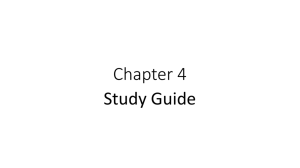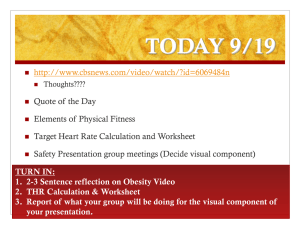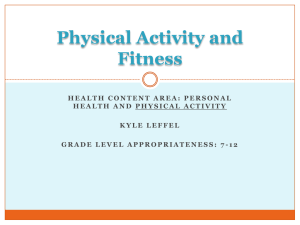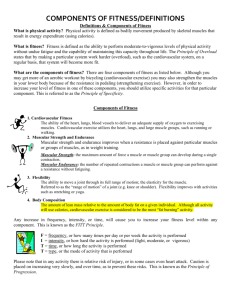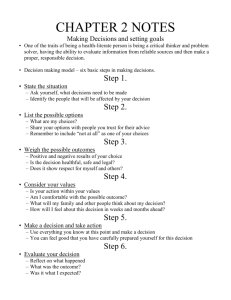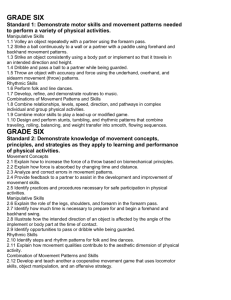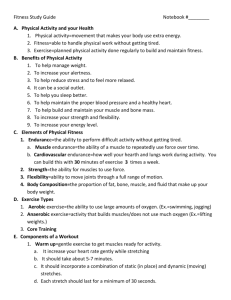Physical Activity Study Guide
advertisement
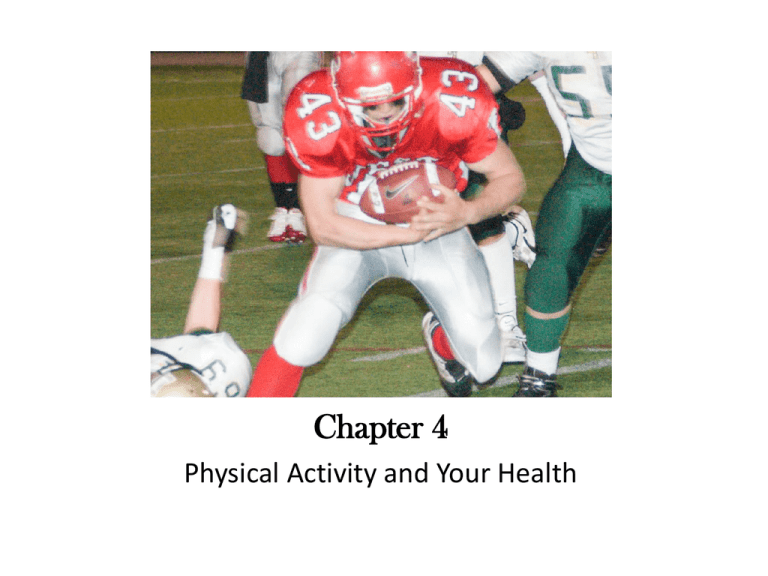
Chapter 4 Physical Activity and Your Health Physical Activity • Any form of movement that causes your body to use energy Physical Fitness • The ability to carry out daily tasks and have enough reserve energy to respond to unexpected demands. Benefits to Physical Health Cardiovascular System – Strengthens the heart muscle, allowing it to pump blood more efficiently Respiratory System - Your respiratory system begins to work more efficiently- you can breathe larger amounts of air, and the muscles used in respiration don’t tire quickly. Helps with Aerobic endurance. Benefits to Physical Health Nervous System – By helping to respond more quickly to stimuli, Physical activity can improve reaction time Benefits to mental/emotional health • It helps reduce stress, helps manage anger. It Improves sleep, mood, and decreases risk of depression. •Helps you look and feel better, which increases your self-confidence. • Contributes to a positive self-concept by giving you a sense of pride and accomplishment in taking care of yourself. • Reduces mental fatigue by bringing more oxygen to the brain. This improves concentration, allowing you to think more clearly and more productively. • Giving you a “can do” spirit when faced with new challenges. Risks of Physical Inactivity • Sedentary Lifestyle1. 2. 3. 4. 5. 6. A way of life that involves very little Physical Activity Unhealthful weight gain, which is linked to several life-threatening conditions: Obesity Cardio vascular disease Type 2 Diabetes Cancer Osteoporosis – a condition characterized by a decrease in bone density, producing porous, fragile bones. They will fracture more than healthy bones Metabolism • Is the process by which your body gets energy from food. 1. Food energy is measured in unit of heat called calories. 2. Your body need a sufficient number of calories each day to function properly. 3. When your physically active your metabolic rate rises and your body burns more calories, than when its at rest. Elements of Fitness 1. Cardiorespiratory Endurance - The ability of the heart lungs and blood vessels to utilize and send fuel and oxygen to the body’s tissues during long periods of moderate-to-vigorous activity. Elements of Fitness 2. Muscular Strength The amount of force a muscle can exert. Elements of Fitness 3. Muscle Endurance – The ability of the muscle to perform physical tasks over a period of time without becoming fatigued. Elements of Fitness 4. Flexibility - The ability of moving a body part through a full range of motion Elements of Fitness 5. Body Composition – The ratio of body fat to lean tissue, including muscle, bone, water and connective tissue such as ligaments cartilage, and tendons. Improving Your Fitness Aerobic Exercise • Is an activity that uses large muscle groups, is rhythmic in nature, and should be maintained continuously for 10 minutes three times a day or for 20 to 30 minutes at one time. Improving Your Fitness Anaerobic Exercise • Involves short bursts of activity in which the muscles work so hard that they produce energy without using oxygen. Types of Resistance Training Isometric • An activity that uses muscular tension to improve muscular strength with little or no movement of the body Part. Types of Resistance Training Isotonic • An activity that combines muscle contraction and repeated movement, through a fuller range of motion Types of Resistance Training Isokinetic • An activity in which a resistance is moved through an entire range of motion at a controlled rate of speed



